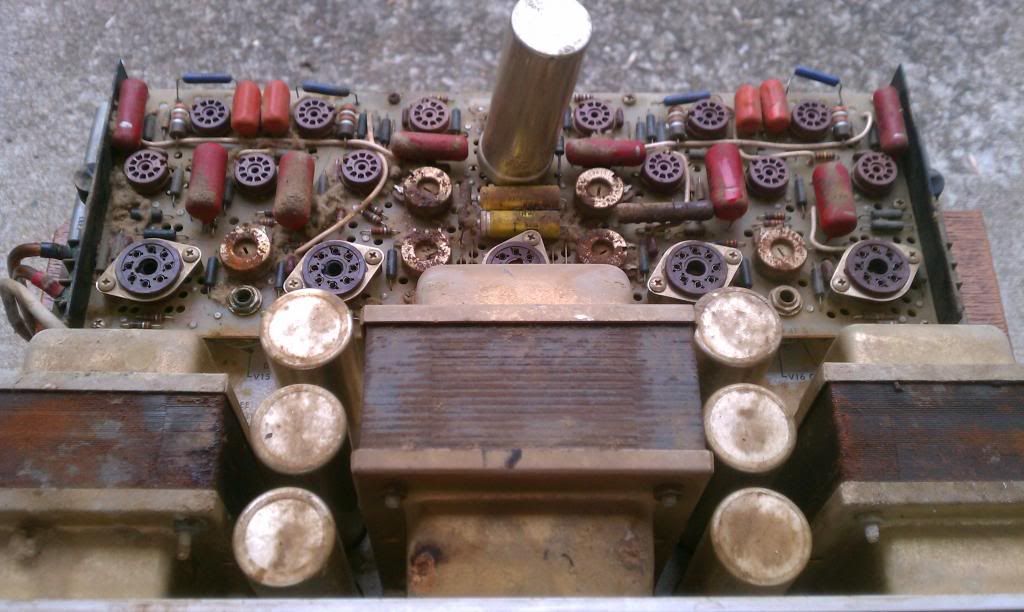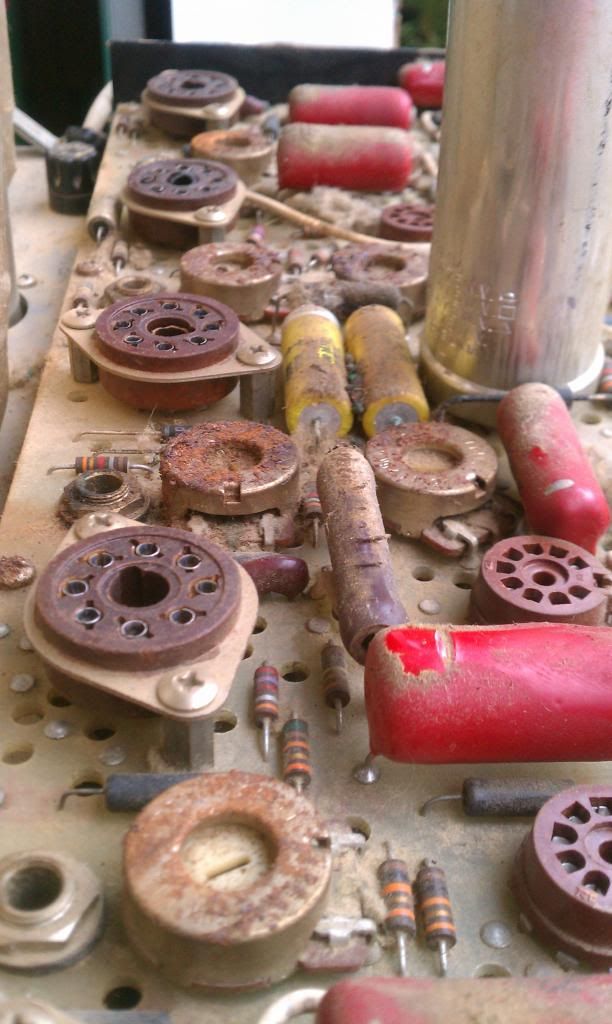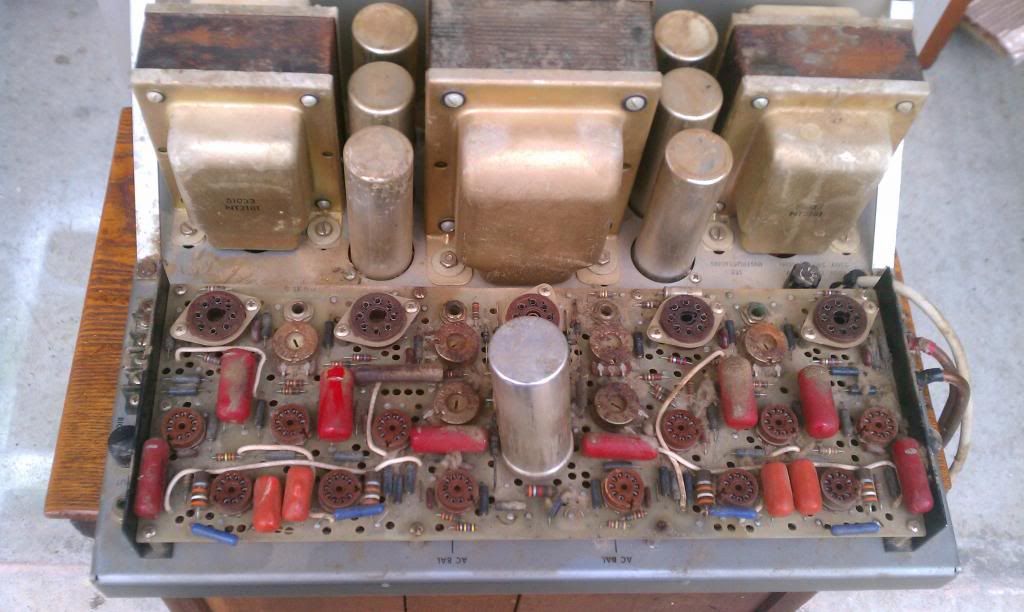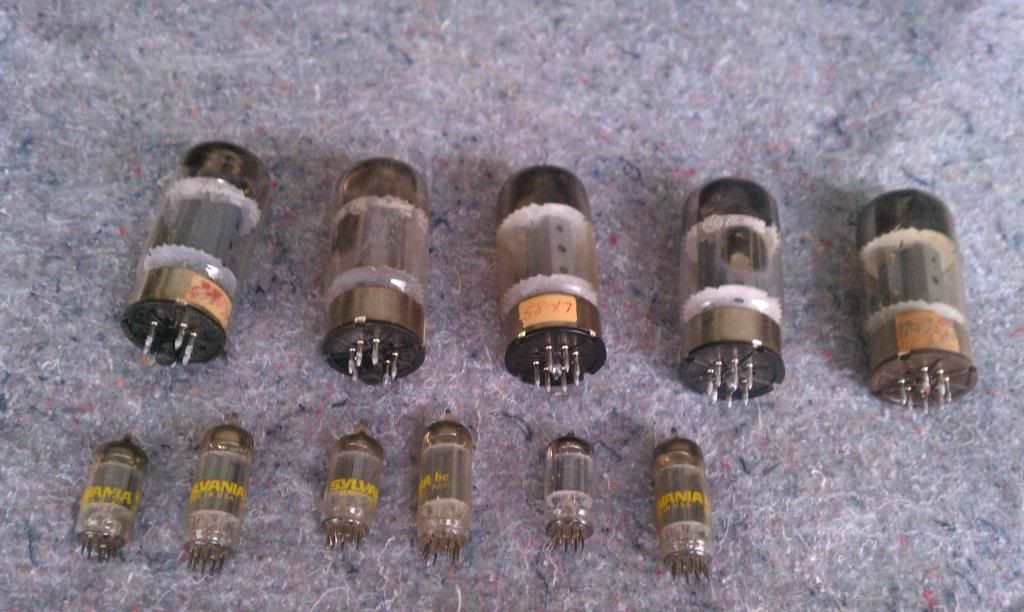You are using an out of date browser. It may not display this or other websites correctly.
You should upgrade or use an alternative browser.
You should upgrade or use an alternative browser.
Audio Research D 76...thoughts?
- Thread starter mikeNC
- Start date
Only problem to be wary of, is that if it shows signs of heat distress on the circuit board, it may be a problem child.
I know of at least one of these amps, locally, that's been passed around from hand-to-hand, because NOBODY can get it to be totally "quiet". Leakage from carbonized/overheated circuit boards causes little cracking and ticking sounds in the background, no matter what.
I don't know of any solution to this, other than changing out the entire circuit board...
Regards,
Gordon.
I know of at least one of these amps, locally, that's been passed around from hand-to-hand, because NOBODY can get it to be totally "quiet". Leakage from carbonized/overheated circuit boards causes little cracking and ticking sounds in the background, no matter what.
I don't know of any solution to this, other than changing out the entire circuit board...
Regards,
Gordon.
goldear
Certifiable Audio Junkie
Yep. That is the problem with the really old units. Baked-boards will eventually cause problems. The other issue is that an amp that old will have to have been recapped at least once, and will probably need it again pretty soon. And circuit boards traces don't take kindly to very many solder-unsolder cycles.
But, if the unit is in decent shape, that is a very nice sounding amp. Personally I prefer the sound of the 6fq7 based ARC circuits over the 6dj8 based circuits.
But, if the unit is in decent shape, that is a very nice sounding amp. Personally I prefer the sound of the 6fq7 based ARC circuits over the 6dj8 based circuits.
Blue Shadow
Waiting for Vintage Gear from this century
Post some better pics of it when you get a chance now that you have it.
If it can be repaired properly for reasonable and the speakers, too, that gear was well bought.
You might want a whole lot more solid state power for the Tympani 1a but the D76 could be a center piece of a very nice tube system.
If it can be repaired properly for reasonable and the speakers, too, that gear was well bought.
You might want a whole lot more solid state power for the Tympani 1a but the D76 could be a center piece of a very nice tube system.
Blue Shadow
Waiting for Vintage Gear from this century
arcdb.ws will get you to a database that has the amp and some information
unless its a piece of absolute trash ; blown xformer or other major issue. if it is cheap I'd buy it
Cheap enough is a real question. Having seen the pics now, hope it was under $200, that would make it the price of the iron and chassis. Tubes would be a nice extra if they work, the small signal tube are probably ok, usually the output tubes are run pretty hard.
Only problem to be wary of, is that if it shows signs of heat distress on the circuit board, it may be a problem child.
I know of at least one of these amps, locally, that's been passed around from hand-to-hand, because NOBODY can get it to be totally "quiet". Leakage from carbonized/overheated circuit boards causes little cracking and ticking sounds in the background, no matter what.
I don't know of any solution to this, other than changing out the entire circuit board...
Regards,
Gordon.
Yep. That is the problem with the really old units. Baked-boards will eventually cause problems. The other issue is that an amp that old will have to have been recapped at least once, and will probably need it again pretty soon. And circuit boards traces don't take kindly to very many solder-unsolder cycles.
But, if the unit is in decent shape, that is a very nice sounding amp. Personally I prefer the sound of the 6fq7 based ARC circuits over the 6dj8 based circuits.
Yup, this one looks like it not only ran hard but spent some time out in a corrosive or humid environment. But nothing like a challenge, huh?
I'd say no matter what, even with a complete strip of components, cleaning and a baking in the oven, the board would probably be suspect. You could always contact ARC and see if they have any replacement boards but I doubt they would sell them to you even if they did - they couldn't guarantee how it gets built or how it will perform once repopulated or reinstalled. But who knows, maybe they would if they had it.
Otherwise, I suspect its a single sided board (of the era), and you could possibly get an offshore PC board shop to make you a few copies for probably not a terrible amount of money. Maybe GordonW's friends could buy the other one (or two) to repair their own. You'd probably have to drill all the venting holes though.
Probably the first order of business is to photograph the heck out of the boards from all angles and top and bottom, showing all part placement and part numbers / values if possible. Correlate that with a tube placement pictorial, jumper pictorial, and then the schematic diagram if you can read it well and get it oriented. That would give you at least a good familiarity with this board and its components.
Then you could start looking for replacement parts - and especially for parts that can take the heat and fit the placement - larger caps will usually stand closer to the tubes and heat up so that's an important consideration. Also, the type of tube sockets they use seem to be mounted on standoffs so I don't quite know how they wire up to the board, likely with little jumpers. All the sockets and pots would need to be replaced as I wouldn't trust them with the corrosion pictured, even with a good cleaning.
I think the chassis and transformers could clean up well, the transformer endbells may be painted or left clean for better heat dissipation. Was there a cage that came with this unit? Figuring how to install a nice low speed fan would be a good idea too.
Course, you could also see if ARC would do the refurbishment - I'm sure they would say yes, just be prepared to spend $$$$, and that's four figures in my estimation, tube not included.
That looks like quite a project. I spent a long time chasing down little noises in my D70 (bad tube socket, and maybe some cold solder joints I reflowed during the chase) but it started out without any corrosion or dirt.
However, if it sounds like the D70 I'd say it is worth some effort. I am really enjoying the ARC tube sound.
However, if it sounds like the D70 I'd say it is worth some effort. I am really enjoying the ARC tube sound.
I'd say no matter what, even with a complete strip of components, cleaning and a baking in the oven, the board would probably be suspect.
I don't see any heat discoloration on first glance. It definitely needs to be stripped and scrubbed, then I'd probably check each trace with a multimeter to make sure resistance across them is 0.
All the sockets and pots would need to be replaced as I wouldn't trust them with the corrosion pictured, even with a good cleaning.
The sockets could be cleaned up with a MIG welder tip cleaner, but I don't really see any reason to do so. For an amp this nice, decent sockets are a cheap investment. It looks like the bottom of the sockets are flush with the board, so they're probably PC mount with the mounting flanges on the octals just used for extra stability. I bought some ceramic 9-pin mini PC mount sockets from a Chinese eBay seller last summer, the quality seems to be fine.
I don't see any horrible corrosion on the end bells of the transformers. If this were my amp, I'd take the transformers off of the chassis, remove the bells and immediately reinstall the bolts through the laminations so they can't get misaligned, then scrub off that rust and give the lamination ends a fresh coat of gloss black. The end bells could be polished up with MAAS or something similar. Edit: the PT seems to have some corrosion on the end bell by the faceplate. Since it's more hidden, I'd probably try to carefully clean the rust/corrosion off and see how it looked with some metal polish. Finishing them off with some liquid carnauba car wax would be a good idea, too.
Last edited:
It looks like it can be repaired (assuming that the transformers are OK) but unless you do your own work I'm not sure it would be worth it.
If you do decide to tackle the repair make sure you ask the group here for a plan of action.
Here's a webpage with information and schematics:
http://www.arcdb.ws/D76/D76.html
If you do decide to tackle the repair make sure you ask the group here for a plan of action.
Here's a webpage with information and schematics:
http://www.arcdb.ws/D76/D76.html
I'd take it on as a project in a heartbeat, but I'm also a rather deranged glutton for punishment. 
I'd take it on as a project in a heartbeat, but I'm also a rather deranged glutton for punishment.
Me too. Looks like fun.
Photograph EVERYTHING!
Pull the board.
Test the transformers.
Clean the board & see what you really have......
Would have to be careful with the traces on the board. Looks like the same crappy board material that CJ used in the MV45's and 75's. Of course that's what was available then so I suppose everyone did...
That actually looks more like the nice translucent green glass fibre stuff that Dynaco used in their late tube gear than the horrible brown phenolic that was used from the early 50s into at least the late 60s.
I wonder why the faceplate looks so nice and clean on both sides while the rest of the amp looks like a boat anchor. Who uses an ARC amp as a boat anchor, anyway?
I wonder why the faceplate looks so nice and clean on both sides while the rest of the amp looks like a boat anchor. Who uses an ARC amp as a boat anchor, anyway?
I have had one of these !I have a chance to pick one up one the cheap....working condition unknown. Wondering if this guy is worth the gamble.
No problem here, clean the unit , and clean both sides of the board
( i use ethanol and a soft brush ). Let i get dry , repeat cleaining
if surface still dirty. Keep clear of tubesockets. The board itself is glassfiber
so it should be ok. Do clean both sides as it's a doublesided board.
Check transformer cables for insulation damage.
Prepare a microphone stereojack with a ammeter connected, fasten
it on a stick so you want burn your fingers when you connect it.
Give the phone-connectors a extra flush with 5-56 ( as their
idle position grounds the cathodes, it's importent that they connect)
As the electrolytes runs at limits, try to turn it on with a variac or
a series connected lightbulb, have all tubes mounted ( in their
original positions) and speaker or power resistors connected as load.
The bias pots looks rusty. Try to verify their function before powerup
but first record their positions so you can use the original positions as
power-up and initial bias.If needed replace them.
When amp is at power connect your ammeter and make shure it idles
at 50 or less mA for each tube.
Balance should be adjusted with distorsion meter or a special hookup
where a differntial input is connected between the catodes.
Good luck!
( and don't start soldering and changing components unless you find
anything broken)
Last edited:
Bill Ferris
Lunatic Member
Yep. That is the problem with the really old units. Baked-boards will eventually cause problems. The other issue is that an amp that old will have to have been recapped at least once, and will probably need it again pretty soon. And circuit boards traces don't take kindly to very many solder-unsolder cycles.
But, if the unit is in decent shape, that is a very nice sounding amp. Personally I prefer the sound of the 6fq7 based ARC circuits over the 6dj8 based circuits.
My circa 1976 D76A is still intact after hundreds + of hours of use !!
Just went through it`s 5 year checkup 3 months ago, and only needed one original small tube replacement..
Caps, circuit traces, performance checks all checked out ..
It is a sonic space heater, but in NE. FL. it hardly gets cold often enough for heating up my room except the few 40` or below nights..
Just remember it`s output is out of phase with any other amp that might be used with it(Bi-amp for example).. Just my added $.02 worth input.. Regards, OKB
arts
Addicted Member
My circa 1976 D76A is still intact after hundreds + of hours of use !!
Just went through it`s 5 year checkup 3 months ago, and only needed one original small tube replacement..
Caps, circuit traces, performance checks all checked out ..
It is a sonic space heater, but in NE. FL. it hardly gets cold often enough for heating up my room except the few 40` or below nights..
Just remember it`s output is out of phase with any other amp that might be used with it(Bi-amp for example).. Just my added $.02 worth input.. Regards, OKB
I really wonder how this worked out for the OP,as the thread died out four years ago.Unless there were transformer problems,it was certainly restorable,but these can scare off the most experienced techs due to complexity. I am a huge Audio Research fan myself,and work on them regularly.I can really relate to the ''sonic space heater'' comment,but up here in Canada it cuts down on the heating bills,so everything works out nicely
http://audiokarma.org/forums/index.php?threads/audio-research-score.675148/
Bill Ferris
Lunatic Member
I really wonder how this worked out for the OP,as the thread died out four years ago.Unless there were transformer problems,it was certainly restorable,but these can scare off the most experienced techs due to complexity. I am a huge Audio Research fan myself,and work on them regularly.I can really relate to the ''sonic space heater'' comment,but up here in Canada it cuts down on the heating bills,so everything works out nicelyHere's my D76A rebuild:
http://audiokarma.org/forums/index.php?threads/audio-research-score.675148/
I`m a big fan too ARC gear too arts.. And you can better utilize the waste heat than I can. I put my rotational tube amps in my unused fireplace when I run them
 ...
...I even used my D76A in 1978 for, believe it or not, as a HF amp in a crossed over at 1000 hz. Bi-amp`d PA(modified EV Eliminator cabinets while running sound for a local rock band while living in Miami, FL. 6 nights a week for 2 months !!!
I guess you might believe that that was a crazy application for such a high quality tube amp !?
Well here`s a more bazaar statement..
The D76A was a upgrade in the PA system after using my Mac MC 225 for a few weeks prior !!

And I don`t have to tell you how smooth the high frequencies sounded through those EV horns with a Phase Linear 400 taking care of the bottom end..
I had a lot of compliments about the SQ from well to do audiophile UM students at the club..
I had already read your D76 rebuild whilst lurking some time back, and enjoyed it, but thanks for including it here..
All I had to ever do to mine was replace the 6550 screen regulator and a 10 k resistor connected to it when my stupid friend was using it for HF bi-amping my Large Advent speakers in his home recording studio and decided to place his condensation dripping cup on the amps cage !!

During a mixdown whilst I wasn`t present !!
After I fixed it he didn`t do that again, as it`s hard to mix to bi-amp`d speakers when you kill the HF amp and no spare amps are about..
That repair and I finally replaced the factory original GE`s with a quartet of Groove tubes(I was a dealer at the time for my audio repair shop) matched # 10 GE`s in the early nineties.. She`s been very good to me for all the years of ownership.
Take care Sir. Kind regards, OKB
Similar threads
- Replies
- 1
- Views
- 1K
- Replies
- 4
- Views
- 313







